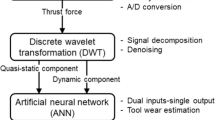Abstract
This paper presents an experimental method for predicting tool wear in drilling Inconel 718 superalloy. The method combines analysis of drilling force signals and tool wear progress. Force characteristics were studied both in time and frequency domains (power spectrum and wavelet decomposition) in order to find best correlation with tool wear progress. These analyses show that the mean value of the thrust force component, the high frequency component of the force, the frequencies that arise during drilling, and the evolution of the wavelet decomposition details are all sensitive to tool wear progress. Therefore, these characteristics can be employed as indicators for drill failure prediction. Among all those indicators, the mean value of the thrust force and the standard deviation of high frequency components of that force have shown the greatest sensitivity to drill wear.













Similar content being viewed by others
Availability of data and materials
Not applicable.
References
Choudhury I, El-Baradie M (1998) Machinability of nickel-base super alloys: a general review. J Mater Process Technol 77:278–284. https://doi.org/10.1016/S0924-0136(97)00429-9
Zhu D, Zhang X, Ding H (2013) Tool wear characteristics in machining of nickel-based superalloys. Int J Mach Tools Manuf 64:60–77. https://doi.org/10.1016/j.ijmachtools.2012.08.001
Sharman ARC, Amarasinghe A, Ridgway K (2008) Tool life and surface integrity aspects when drilling and hole making in Inconel 718. J Mater Process Technol 200:424–432. https://doi.org/10.1016/j.jmatprotec.2007.08.080
Uçak N, Çiçek A (2018) The effects of cutting conditions on cutting temperature and hole quality in drilling of Inconel 718 using solid carbide drills. J Manuf Process 31:662–673. https://doi.org/10.1016/j.jmapro.2018.01.003
Beer N, Özkaya E, Biermann D (2014) Drilling of Inconel 718 with geometry-modified twist drills. Proc CIRP 24:49–55. https://doi.org/10.1016/j.procir.2014.07.124
Finkeldei D, Sexauer M, Bleicher F (2019) End milling of Inconel 718 using solid Si3N4 ceramic cutting tools. Proc CIRP 81:1131–1135. https://doi.org/10.1016/j.procir.2019.03.280
Wojciechowski S, Talar R, Zawadzki P, Wieczorowski M (2020) Evaluation of physical indicators and tool wear during grooving of spheroidal cast iron with a novel WCCo/cBN (BNDCC) inserts. Wear 454–455:203301. https://doi.org/10.1016/j.wear.2020.203301
Wojciechowski S, Talar R, Zawadzki P, Legutko S, Maruda R, Prakash C (2020) Study on technological effects of a precise grooving of AlSi13MgCuNi alloy with a novel WCCo / PCD. Materials (Basel) 13
Marques A, Paipa Suarez M, Falco Sales W, Rocha MÁ (2019) Turning of Inconel 718 with whisker-reinforced ceramic tools applying vegetable-based cutting fluid mixed with solid lubricants by MQL. J Mater Process Technol 266:530–543. https://doi.org/10.1016/j.jmatprotec.2018.11.032
Khanna N, Agrawal C, Gupta MK, Song Q (2019) Tool wear and hole quality evaluation in cryogenic drilling of Inconel 718 superalloy. Tribol Int 106084. https://doi.org/10.1016/j.triboint.2019.106084
Pimenov DY, Guzeev VI, Krolczyk G, Mia M, Wojciechowski S (2018) Modeling flatness deviation in face milling considering angular movement of the machine tool system components and tool flank wear. Precis Eng 54:327–337. https://doi.org/10.1016/j.precisioneng.2018.07.001
Chen YC, Liao YS (2003) Study on wear mechanisms in drilling of Inconel 718 superalloy. J Mater Process Technol 140:269–273. https://doi.org/10.1016/S0924-0136(03)00792-1
Liu J, Shao XJ, Liu YJ, Liu YS, Yue ZF (2007) The effect of holes quality on fatigue life of open hole. Mater Sci Eng A 467:8–14. https://doi.org/10.1016/j.msea.2007.02.060
Liu J, Yue ZF, Liu YS (2007) Surface finish of open holes on fatigue life. Theor Appl Fract Mech 47:35–45. https://doi.org/10.1016/j.tafmec.2006.10.008
Nouari M, List G, Girot F, Géhin D (2005) Effect of machining parameters and coating on wear mechanisms in dry drilling of aluminium alloys. Int J Mach Tools Manuf 45:1436–1442. https://doi.org/10.1016/j.ijmachtools.2005.01.026
Thangaraj A, Wright PK (1988) Drill wear sensing and failure prediction for untended machining. Robot Comput Integr Manuf 4:429–435. https://doi.org/10.1016/0736-5845(88)90014-2
Lin SC, Ting CJ (1995) Tool wear monitoring in drilling using force signals. Wear 180:53–60. https://doi.org/10.1016/0043-1648(94)06539-X
Ertunc HM, Oysu C (2004) Drill wear monitoring using cutting force signals. Mechatronics 14:533–548. https://doi.org/10.1016/j.mechatronics.2003.10.005
Chandrasekharan V, Kapoor SG (1995) A mechanistic approach to predicting the cutting forces in drilling with application to fiber-reinforced composite materials 1
Harun MHS, Ghazali MF, Yusoff AR (2017) Analysis of tri-axial force and vibration sensors for detection of failure criterion in deep twist drilling process. Int J Adv Manuf Technol 89:3535–3545. https://doi.org/10.1007/s00170-016-9344-3
Eckstein M, Mankova I, Vrabel M, Beno J (2015) Comparison of sensors signal quality when drilling Inconel 718. Proc CIRP 33:227–232. https://doi.org/10.1016/j.procir.2015.06.041
Eckstein M, Vrabeľ M, Maňková I (2017) Application of discrete wavelet decomposition in monitoring of hole-making Inconel 718. Proc CIRP 62:250–255. https://doi.org/10.1016/j.procir.2016.06.023
Ahmed A, Lew MT, Diwakar P, Kumar AS, Rahman M (2019) A novel approach in high performance deep hole drilling of Inconel 718. Precis Eng 56:432–437. https://doi.org/10.1016/j.precisioneng.2019.01.012
Attanasio A, Faini F, Outeiro JC (2017) FEM simulation of tool wear in drilling. Proc CIRP 58:440–444. https://doi.org/10.1016/j.procir.2017.03.249
Attanasio A, Ceretti E, Outeiro J, Poulachon G (2020) Numerical simulation of tool wear in drilling Inconel 718 under flood and cryogenic cooling conditions. Wear 458–459:203403. https://doi.org/10.1016/j.wear.2020.203403
Mehrabad VZ, Pourmostaghimi V (2017) Tool wear modeling in drilling process of AISI1020 and AISI8620 using genetic programming. Int J Adv Des Manuf Technol 10:93–100
Misiti M, Misiti Y, Oppenheim G, Poggi J-M (1996) Wavelet toolbox. The MathWorks, Inc.
Author information
Authors and Affiliations
Contributions
Amaia Jiménez: validation, analysis, investigation, writing of the original draft.
Miguel Arizmendi: software, analysis, investigation, writing review.
José Manuel Sánchez: conceptualization, analysis, writing review.
Corresponding author
Ethics declarations
Ethics approval
This paper is our original unpublished work, and it has not been submitted to any other journal for reviews.
Consent to participate
All authors were fully involved in the study and preparation of the manuscript; each of the authors has read and concurs with the content in the final manuscript.
Consent for publication
All authors consent to publish the content in the final manuscript.
Competing interests
The authors declare no competing interests.
Additional information
Publisher’s note
Springer Nature remains neutral with regard to jurisdictional claims in published maps and institutional affiliations.
Rights and permissions
About this article
Cite this article
Jiménez, A., Arizmendi, M. & Sánchez, J.M. Extraction of tool wear indicators in peck-drilling of Inconel 718. Int J Adv Manuf Technol 114, 2711–2720 (2021). https://doi.org/10.1007/s00170-021-07058-7
Received:
Accepted:
Published:
Issue Date:
DOI: https://doi.org/10.1007/s00170-021-07058-7



